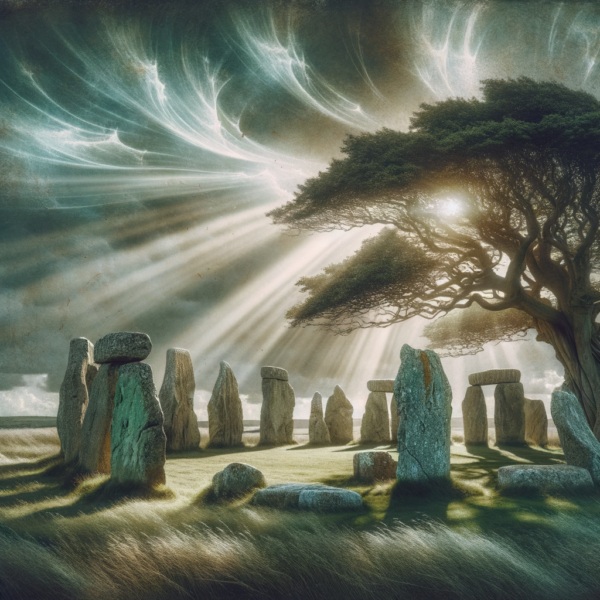Nestled in the heart of Wiltshire, England, the Avebury Stone Circle stands as a testament to the ingenuity and spiritual beliefs of our Neolithic ancestors. This awe-inspiring monument, located approximately 20 miles north of Stonehenge, is part of a larger prehistoric landscape that has captivated visitors for centuries.
Avebury’s stone circle is the largest megalithic stone circle in the world, encompassing an area of about 28.5 acres. The site consists of a massive circular bank and ditch, within which lies an outer circle of standing stones and two smaller inner circles. This complex was constructed over several hundred years, beginning around 2850 BC and continuing until about 2200 BC.
The Magnificent Avebury Structure
The Avebury complex is a marvel of prehistoric engineering. Its key features include:
- A circular henge (bank and ditch) with a circumference of about 1.3 kilometers
- An outer circle of approximately 100 standing stones
- Two smaller inner circles, each with distinct features
- The remains of stone avenues leading to other nearby Neolithic sites
The outer circle originally comprised between 98 and 105 sarsen stones, some weighing up to 40 tons. Today, only 27 of these stones remain standing, offering a glimpse of the circle’s former grandeur.
The Inner Circles of Avebury
Within the massive outer circle lie two smaller stone circles, each with its own unique characteristics:
- The Northern Inner Circle: This circle once contained 27 stones and featured a central monument known as “The Cove,” consisting of three large stones arranged in a U-shape.
- The Southern Inner Circle: Slightly smaller than its northern counterpart, this circle originally held 29 stones. At its center stood an impressive obelisk, estimated to have been 21 feet tall.
The Circle’s Purpose and Significance
The exact purpose of Avebury remains a mystery, much like other Neolithic monuments. However, archaeologists and historians have proposed several theories:
- Ceremonial and Ritual Site: The complex layout and immense effort required to build Avebury suggest it was a place of great importance for religious or spiritual ceremonies.
- Astronomical Observatory: Some researchers believe the stone alignments may have been used to track celestial movements and mark important dates in the agricultural calendar.
- Community Gathering Place: The site might have served as a central location for scattered Neolithic communities to come together for social and economic purposes.
- Symbol of Power and Unity: The construction of such a massive monument could have been a way for Neolithic people to demonstrate their collective strength and social organization.
Construction and Engineering
Building Avebury was an incredible feat of engineering for its time. The process likely involved:
- Digging the massive henge ditch using antler picks and shoulder blades of cattle as shovels
- Transporting huge sarsen stones, some weighing up to 40 tons, from nearby fields
- Erecting the stones using a combination of manpower, ropes, and wooden rollers
- Aligning the stones and circles with precision, possibly using astronomical observations

The sheer scale of the project suggests a well-organized society with strong leadership and a shared vision.
Avebury Through the Ages
The story of Avebury extends far beyond its Neolithic origins:
- Bronze and Iron Ages: The site saw continued use, with evidence of burials and other activities within the henge.
- Roman Period: There are signs of Roman occupation near the site, though its religious significance may have diminished.
- Medieval Era: A village began to grow within and around the stone circle. Many stones were toppled or buried during this time due to changing religious beliefs and practical needs.
- 17th and 18th Centuries: Antiquarians like John Aubrey and William Stukeley documented the site, raising awareness of its historical importance.
- 20th Century: Alexander Keiller led efforts to restore and preserve the site, including re-erecting many fallen stones.
Avebury Today
Today, Avebury is a UNESCO World Heritage Site, managed by the National Trust and English Heritage. It continues to draw visitors from around the world, fascinated by its ancient mystery and enduring beauty.
The site offers a unique experience compared to other prehistoric monuments:
- Visitors can freely walk among the stones, touching and experiencing them up close.
- The village of Avebury, nestled within the stone circle, provides a charming backdrop to the ancient stones.
- The Alexander Keiller Museum offers insights into the site’s history and archaeological discoveries.
Avebury’s Mystical Appeal
Avebury holds a special place in modern spiritual practices:
- Neo-Pagan and Druid groups often conduct ceremonies at the site, especially during solstices and equinoxes.
- Many visitors report feeling a strong energy or sense of peace when walking among the stones.
- The site’s connection to the surrounding landscape, including nearby Silbury Hill and West Kennet Long Barrow, adds to its mystical allure.
Preserving Avebury for Future Generations
Efforts to protect and study Avebury are ongoing:
- Archaeologists continue to make new discoveries using non-invasive techniques like ground-penetrating radar.
- Conservation work ensures the stones and earthworks remain stable and protected from erosion.
- Educational programs help visitors understand the site’s importance and encourage respectful exploration.
The Wider Prehistoric Landscape
Avebury is part of a larger Neolithic landscape that includes:
- Silbury Hill: The largest man-made mound in Europe, its purpose remains a mystery.
- West Kennet Long Barrow: An impressive Neolithic tomb predating Avebury by several centuries.
- The Sanctuary: A circular temple site connected to Avebury by the West Kennet Avenue.
- Windmill Hill: A causewayed enclosure that may have been an early gathering place for Neolithic people.
These sites, along with Avebury, form a complex tapestry of Neolithic life and beliefs that continues to intrigue and inspire us today.
Avebury Stone Circle stands as a monumental achievement of our ancestors. It invites us to ponder the beliefs, skills, and aspirations of those who came before us. As we walk among these ancient stones, we connect with a distant past that still holds many secrets, waiting to be understood.





